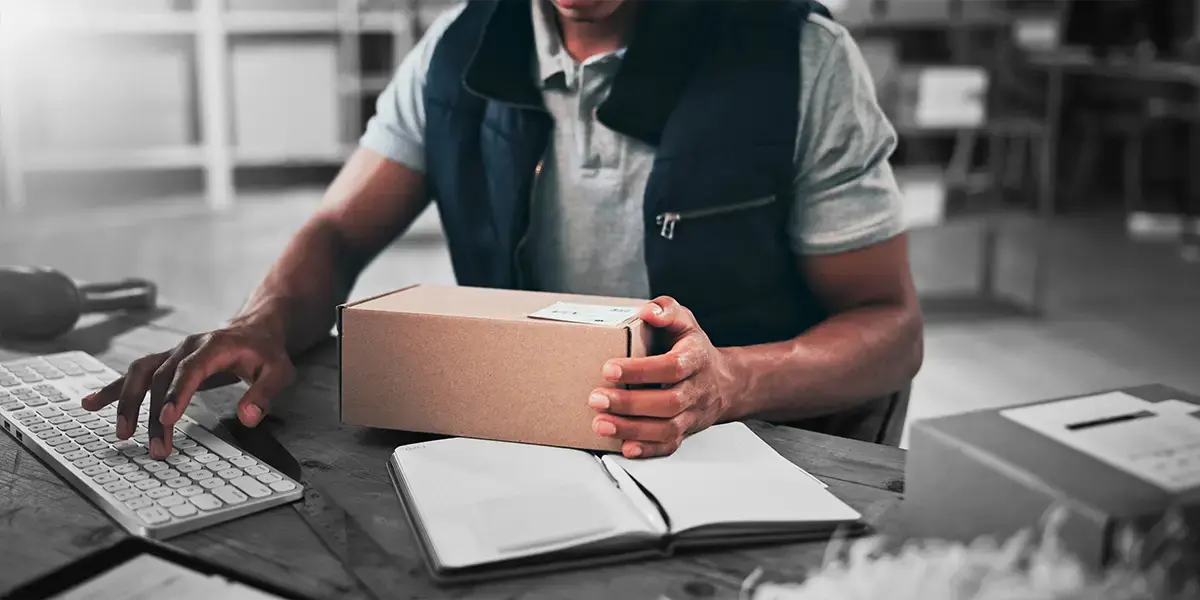
Last update: 24.07.2025
In this blog:
- The cognitive dissonance of modern e-commerce
- The neuroscience of purchase confidence
- The trust paradox: why liberal returns drive sales
- The B2C heart vs. the B2B brain: two return realities
- How to: audit your returns psychology
- The academic perspective: insights from research
- What's next: a strategic shift
- Further reading: Psychology of returns FAQs
The cognitive dissonance of modern e-commerce
Here's a paradox that could have made Nobel laureate Daniel Kahneman (psychologist on the psychology of judgment and decision-making as well as behavioral economics) raise an eyebrow: e-commerce leaders are simultaneously terrified of returns while also needing them to drive growth.
Global returns now account for 14-15% of retail sales, with e-commerce rates hitting 17.3% versus just 10% for in-store purchases. In the UK alone, online shoppers returned £27 billion worth of goods in 2024, which is roughly the GDP of Iceland flowing backward through the supply chain.
Yet this trillion-dollar reverse logistics market, projected to grow by $250 billion over the next five years to reach $954.5 billion, represents more than just cost recovery. It's a masterclass in consumer psychology waiting to be decoded.
The neuroscience of purchase confidence
The same study found that 54% of shoppers say “easy” returns are very important, and that 35% of UK shoppers sent back at least one purchase in 2023, totaling £4.2 billion in returned goods. Together, these figures underscore a dramatic shift in consumer expectations: returns are no longer an operational afterthought; they’re a trust litmus test.
Recent research from the Management Review Quarterly reveals that the substantial growth of e-commerce during the last years has led to a surge in consumer returns, with research interest in consumer returns growing steadily due to the availability of vast customer data and advancements in machine learning. But here's what the data scientists might miss: returns aren't just about logistics, they're about confidence.
Consider the psychological mechanics at play. When a customer sees a generous returns policy, their brain doesn't just process "I can return this if needed." Instead, it processes "This brand trusts its products enough to let me change my mind." This confidence signal is so powerful that 76% of UK shoppers now expect free return shipping, not because they plan to return items, but because free returns represent psychological safety.
The trust paradox: why liberal returns drive sales
Research consistently reveals that liberal return policies significantly increase initial purchase rates more than actual return rates.
Narvar’s consumer research reinforces this dynamic:
- 87% of shoppers say free returns impact their decision to buy.
- Over 60% check return policies before making a purchase.
- 96% of shoppers who had an “easy” or “very easy” return experience say they would shop with that retailer again.
- Retailers using strategic returns processes see up to 15x ROI from exchanges and product recommendations during the return flow.
The mere knowledge of easy returns provides psychological relief, prompting customers to buy more confidently. The mere knowledge of easy returns provides psychological relief, prompting customers to buy more confidently.
This phenomenon is especially pronounced in Nordic markets, where 74% of Swedish customers who experience poor returns processes avoid shopping with that retailer again. Conversely, a seamless returns experience creates loyal customers who actively promote the brand, boosting sales frequency and volume.
The B2C heart vs. the B2B brain: two return realities
The psychology of returns diverges sharply between B2C and B2B, and recognizing this is essential for designing effective return strategies.
B2C returns: emotional discovery moments
In B2C, returns are deeply emotional. They're triggered by disappointment, sizing issues, or what behavioral economists call “bracketing”; ordering multiple variations of a product (sizes, colors, models) with the intention of keeping only one. This is not fraud, it’s adaptation. The traditional fitting room has been replaced by the consumer's living room.

What looks like a return is often a preference signal. For instance, when a customer returns a size Medium shirt and reorders a Large, they’re not just making an exchange; they’re training your algorithm. This feedback loop is gold for personalization engines, sizing tools, and predictive analytics.
More importantly, smooth return experiences reinforce customer trust and brand loyalty, especially in categories like apparel, where return rates can exceed 30% in some markets.
B2B returns: strategic risk mitigation
In contrast, B2B returns are rarely emotional, they’re high-stakes, calculated risks. Procurement teams operate under pressure to minimize costly errors, and returns can carry career-limiting consequences.
According to DHL’s B2B eCommerce Report, 68% of B2B buyers closely examine a supplier’s return policy before placing an order. This scrutiny reflects the operational and reputational risks at play, especially with high-ticket or customized items.
B2B returns often involve:
- Complex approval chains
- Larger quantities or bulk orders
- Specialized goods with resale limitations
- Coordination between suppliers, logistics teams, and finance
While B2C returns signal discovery, B2B returns often signal breakdown of communication, fit, or spec alignment. That’s why the best B2B sellers use proactive onboarding, digital configuration tools, and clear return terms to preempt issues before they become friction.
How to: audit your returns psychology
Step 1: Behavioral segmentation analysis
- Analyze your returns data by customer segment
- Identify patterns: Are returns coming from new customers testing your brand, or existing customers exploring new product categories?
- Map the emotional journey: What triggers a return request, and how does that map to customer lifecycle stages?
Step 2: The confidence signal audit
- Review your returns policy language. Does it sound like a legal document or a confidence-building tool?
- A/B test different returns messaging. Test "hassle-free returns" against "we stand behind our products"
- Measure the impact on conversion rates, not just return rates
Step 3: Cost-per-confidence calculation
- Instead of calculating returns purely as cost, calculate them as customer acquisition cost. If liberal returns drive higher initial conversion and customer lifetime value, they're marketing expenses, not necessarily operational costs.
The academic perspective: insights from research
Recent literature reviews on e-commerce returns management show that a lot of academic research has focused on logistics optimization rather than behavioral psychology. However, emerging research in behavioral economics suggests that returns serve as a "confidence anchor" in the customer decision-making process.
A fascinating finding from recent academic work is what researchers call the "returns paradox": companies with the most liberal return policies often have the lowest actual return rates. This isn't because their products are better; it's because their customers are more confident in their purchases.
Environmental psychology: converting guilt to loyalty
In environmentally conscious markets like the Nordics, customers frequently experience "eco-guilt" over returns. Retailers that transparently communicate efficient processes, restocking, refurbishing, and recycling transform guilt into participation in the circular economy, significantly boosting brand loyalty.
The data goldmine in every return
Every return tells a story. It's a customer saying, "I trusted you enough to buy, but something went wrong." That's not just a transaction to reverse, it's market research delivered to your door. Returns data is market intelligence delivered directly by customers:
- Identifying product quality concerns early
- Highlighting sizing and description inaccuracies
- Revealing real-time shifts in consumer preferences
- Informing predictive analytics and personalization strategies
Smart retailers leverage this data to enhance product offerings, minimizing future returns while boosting customer satisfaction and loyalty.
What's next: a strategic shift
 Future success won't lie in minimizing returns but in strategically leveraging them to enhance customer lifetime value. This requires a fundamental mindset shift from viewing returns as a cost center to embracing them as critical trust-building opportunities.
Future success won't lie in minimizing returns but in strategically leveraging them to enhance customer lifetime value. This requires a fundamental mindset shift from viewing returns as a cost center to embracing them as critical trust-building opportunities.
In Part 2, we will explore how nShift Returns directly addresses the challenges outlined here. From simplifying the customer returns experience and strengthening consumer trust, to enabling flexible returns policies that drive conversion, nShift Returns helps retailers turn returns into a strategic advantage.
By streamlining reverse logistics workflows, automating approvals, and improving visibility across the returns journey, the nShift Platform allows merchants to reduce friction for both consumers and internal teams.
For now, embrace this mindset: your returns aren't problems, they’re essential opportunities for building deep customer confidence, arguably the scarcest resource in modern e-commerce.
This blog is part #1 of a series; to continue, read part #2 here.
Make returns simple for your customers & smarter for you
nShift Returns delivers branded, self-service experiences while giving you the tools to prevent avoidable returns, automate refunds, and restock faster.
Discover more
Further reading: Psychology of returns FAQs
What cognitive biases drive online shoppers when it comes to returns?
Common cognitive biases include loss aversion, where customers fear losing money on a poor product choice, and the endowment effect, which makes them feel more attached to items after ownership. These psychological factors influence how return policies are perceived and used.
How do liberal return policies impact customer purchase decisions?
Liberal return policies act as a “confidence trigger” by reducing purchase anxiety. Shoppers are more likely to buy if they know they can return easily—especially for high-consideration or first-time purchases.
What is the psychological “confidence signal” in return experiences?
A “confidence signal” is the impression a brand gives that returns are simple and fair. Clear, customer-friendly policies act as trust indicators that reduce buyer hesitation and increase conversion rates.
How do B2C and B2B return behaviors differ psychologically?
B2C returns are often emotional and driven by personal preference or convenience, while B2B returns are more logic- and contract-driven. However, both are influenced by how frictionless and transparent the return process is.
What is behavioral segmentation analysis in returns management?
Behavioral segmentation groups customers based on return behaviors—such as chronic returners, loyal buyers, or one-time users. This helps tailor return policies and automation rules for each customer type.
How can a confidence signal audit improve returns strategy?
A confidence signal audit evaluates how your return policies are presented across channels—from product pages to emails and portals. It identifies gaps where unclear language or process friction may erode trust.
What is the cost-per-confidence calculation for return policies?
Cost-per-confidence measures how much a return policy costs in relation to the trust and conversion uplift it creates. This helps companies balance financial risk with the psychological reward of easier returns.
How do returns function as a trust-building tool for brands?
Returns signal transparency and accountability. Customers who experience smooth returns are more likely to trust the brand, write positive reviews, and make repeat purchases.
Why do easy returns increase customer loyalty and repeat purchases?
Easy returns lower post-purchase risk, leading to higher satisfaction. When customers know they won’t be penalized for returning, they feel safer trying new products—driving repeat orders and brand advocacy.
What behavioral data should companies track to optimize return flows?
Key data includes return reasons, frequency per customer, product return rates, time to return, and refund speed. Layering this with customer segments allows brands to refine policies and automate processes intelligently.
References
- Global Returns Volume (14.5%, $743B)
- Online vs In-Store Return Rates (17.3% vs. 10%)
- UK Online Returns (£27 Billion, 2024 Forecast)
- UK Online Returns (£4.2 Billion, 2023 Actual)
- 74% of Swedish Shoppers Avoid Retailers After a Poor Return Experience
- Liberal Returns Increase Conversion More Than Returns
- B2B Return Policy Importance (68%)
- 76% of Shoppers Expect Free Return Shipping

Author
Thomas Bailey
Product Innovation Lead, nShift
Thomas plays a key role in shaping how new features and platform improvements deliver real value to customers. With a background spanning product, tech, and go-to-market strategy, he brings a pragmatic view of what innovation looks like in practice and how to make delivery experiences work harder for your business.

About the author
Thomas Bailey
Thomas plays a key role in shaping how new features and platform improvements deliver real value to customers. With a background spanning product, tech, and go-to-market strategy, he brings a pragmatic view of what innovation looks like in practice and how to make delivery experiences work harder for your business.



